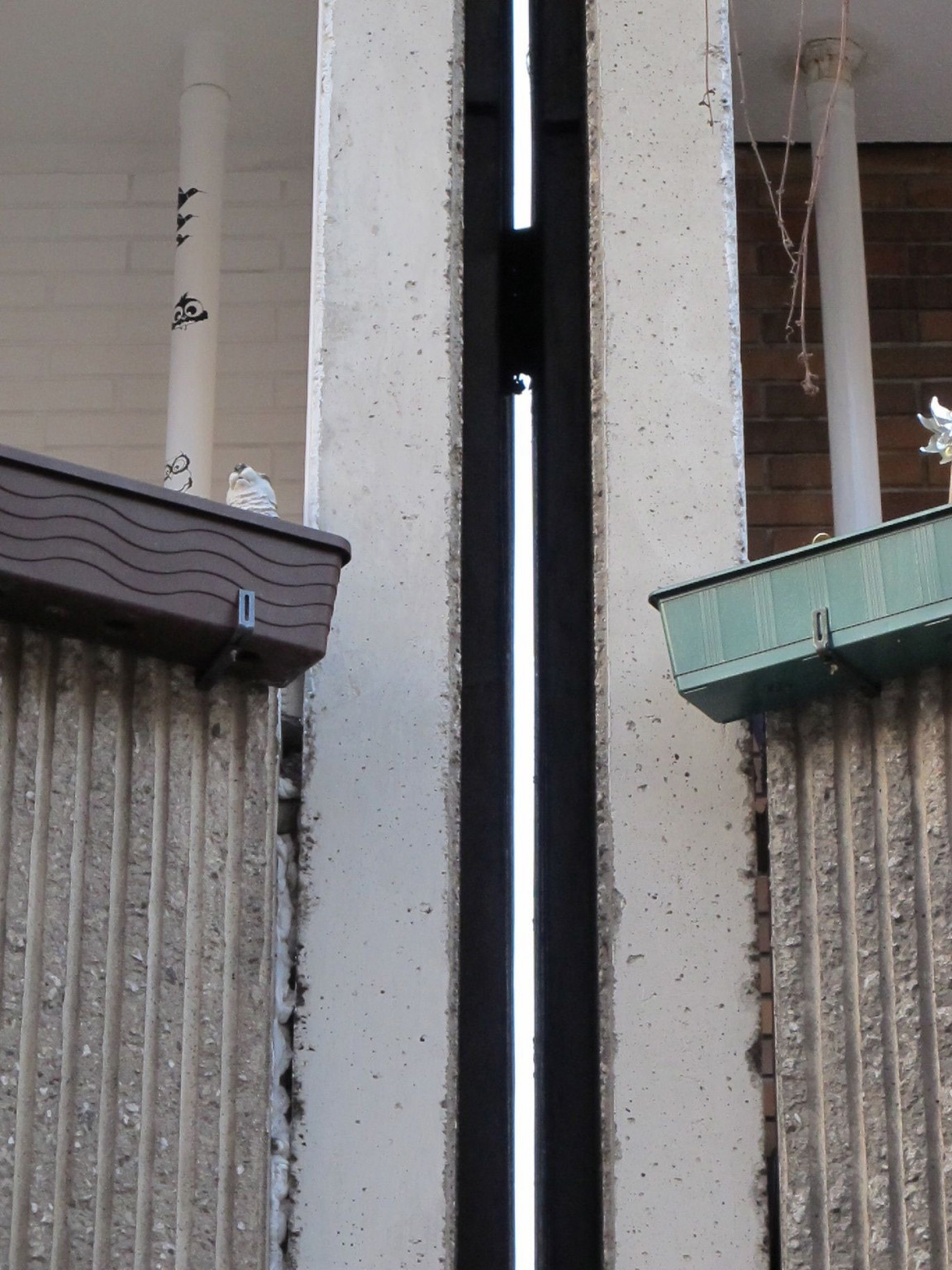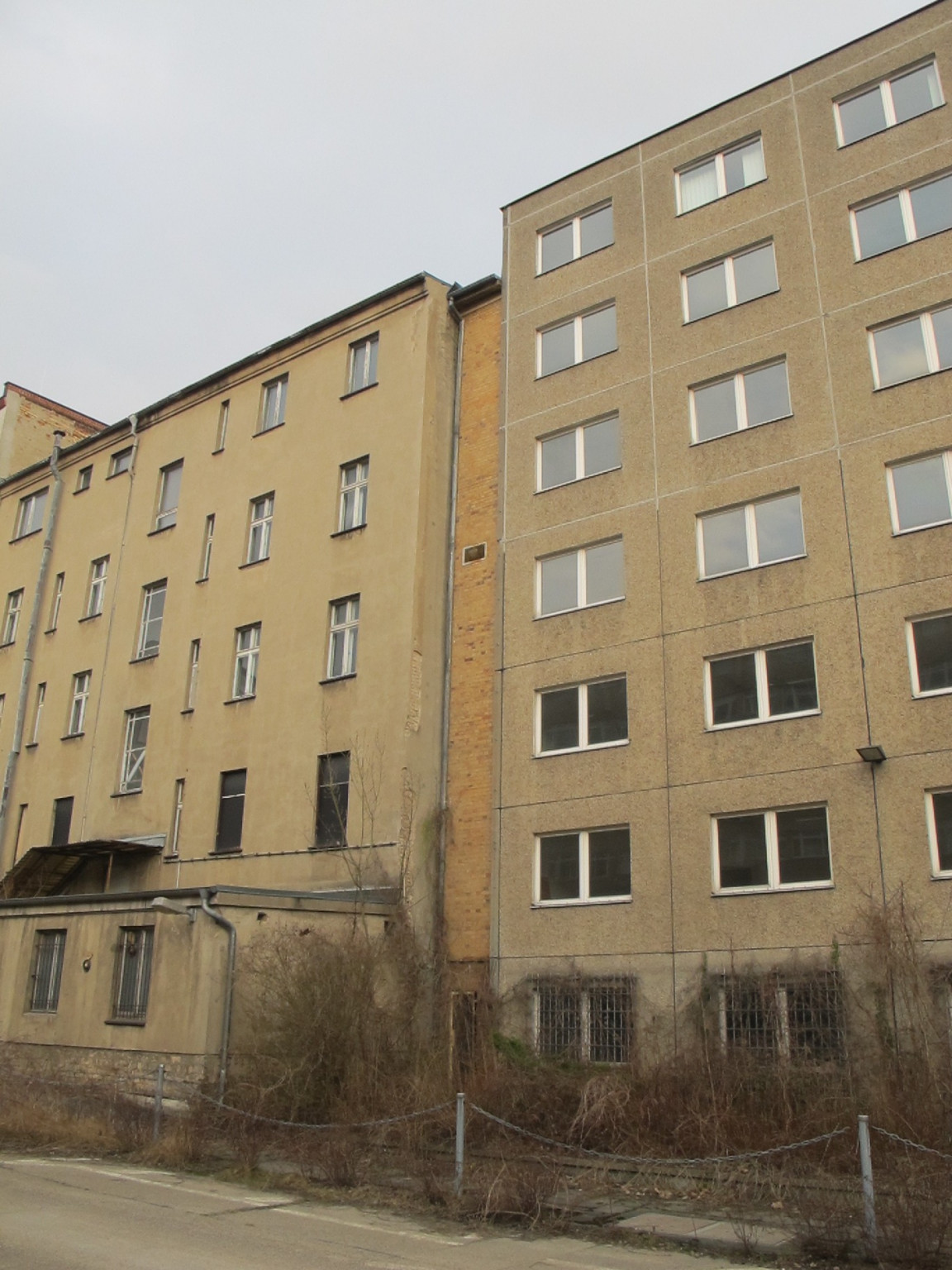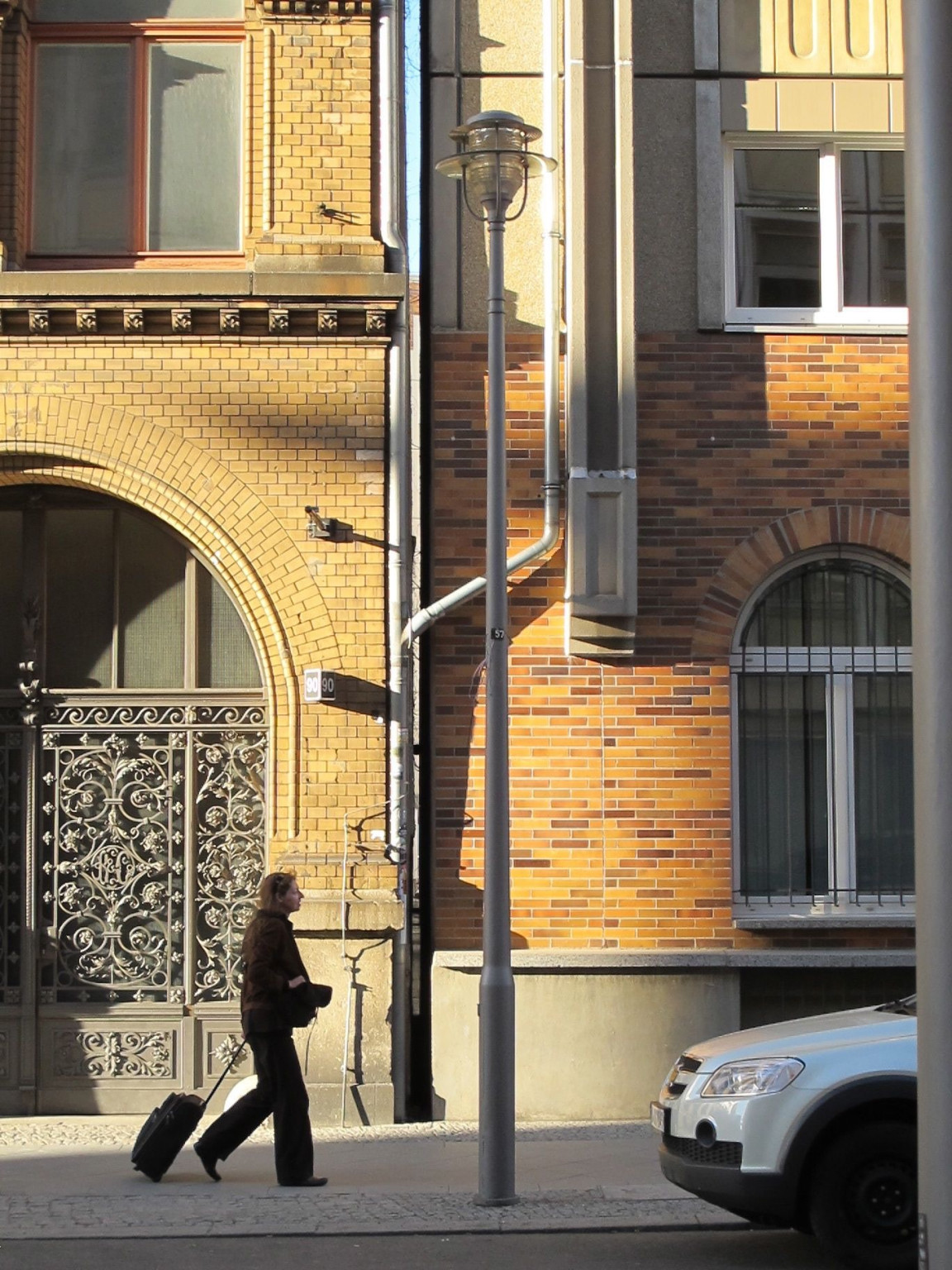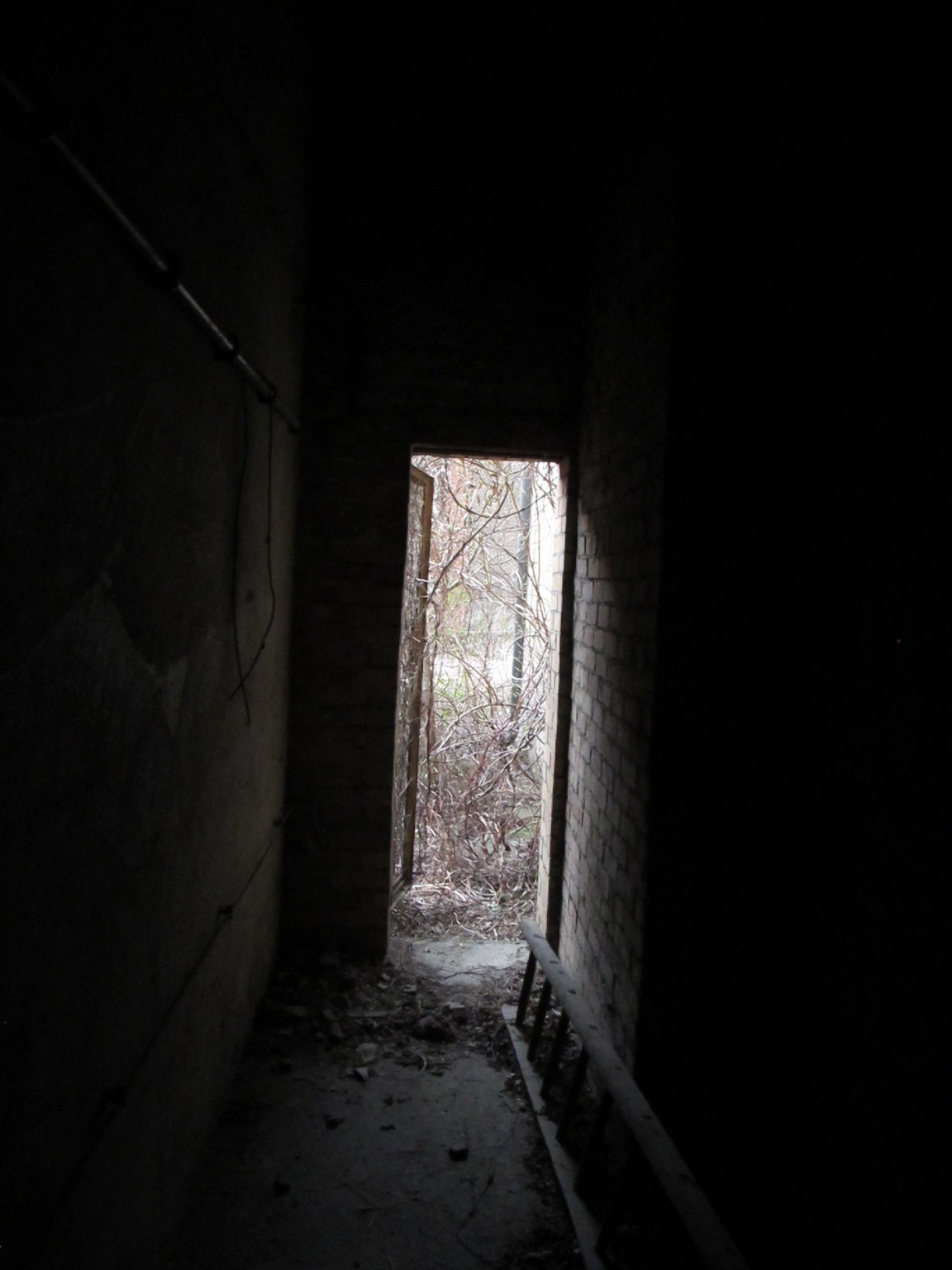1.
Apartment blocks built in the 1980s have left strange blank spaces in East German cities, particularly Berlin. There are many unsightly gaps from one house to the next, especially between Wilhelminian and communist buildings. These gaps, which I call Sollbruchstellen, or predetermined breaking points, were created because Plattenbauten, buildings made with large prefabricated concrete slabs, could seldom fit seamlessly into the smaller streets and alleys of the inner-city districts.
2.
The Sollbruchstellen in East Berlin were left as bounced architectural cheques from the bankrupt assets of the German Democratic Republic (GDR). Before the fall of the Wall in 1989, the gaps were tacitly accepted; and afterwards, in the initially confusing period of transition, they were forgotten. Decades have passed, and we are still hardly aware of their presence.
3.
The width and depth of the gaps depend, of course, on the layout of the plot, the precious piece of land. No omission is like the next. Communist Sollbruchstellen are a veritable joke in the history of construction, individualistic loners that refuse any standardization. A narrow, barely visible scratch on the street side can turn out to be a substantial scar on the courtyard side and vice versa. There were weeks in which I spent every free minute on my bicycle to document their presence.
4.
The art historian Karl Scheffler declared in 1910, in a famous bon mot: “Berlin is damned forever to become and never to be.”
It is remarkable that the lack of freedom in the GDR has created architectural blanks, which still disappear in Berlin’s cityscape as if they were chameleons, in spite of the city’s addiction to change.
5.
A city famous for looking closely and locking up quickly, a city known for the killer instinct of its border guards, a city noted and notorious for its “anti-fascist protective wall”—den antifaschistischen Schutzwall, a term the dictatorial Communist rulers loved to use as an argument to defend Die Mauer—Berlin allowed undefined apertures between the buildings in its Mitte during the existence of the Wall from 1961 to 1989. As if the East German architects had taken psychedelic drugs and indulged in the cult of the gap.
6.
There is an accumulation of Sollbruchstellen in the area between Spandauer Vorstadt—including the Scheunenviertel, Rosenthaler, and Oranienburger Vorstadt—and the extensive area around Alexanderplatz and Alt-Berlin, including the Nikolai Quarter.


7.
Despite the difference in age and ideology, bricks and slabs move together in Eastern German cities without being formally introduced. A deranged marriage, often in the best downtown locations. As a dowry: the formidable empty spaces of Sollbruchstellen; Brecht and the estrangement effect are sending their kind regards. In many ménage à trois, a new building between two old buildings created two impressive gaps, one at each side. In the final stages, the communist Arbeiterdämmerung, people built as best they could, and they could not build very well at all. Slab and brick were alienated. Living side by side untouched. Kept their distance. Strange abysses opened up between new and old houses. A misalliance, certainly. Foreign bodies not made for each other.
8.
According to Alexander Mitscherlich, the shaped (hospitable) city could become a home, but the merely conglomerated (inhospitable) city could not. Heimat: an almost untranslatable German word that means more than home and might be defined as a spatial and social entity wherein a person feels safe and perceives the dependability of its existence.
9.
Curiously, Sollbruchstellen satisfy two functions: they shape and distort space at the same time. The desire to search out the gaps—which has overwhelmed me regularly since spring 2013—possibly represents, in Mitscherlich’s sense, a greed for authenticity. And East Berlin has proved to be quite bountiful, almost generous in terms of the supply of Sollbruchstellen.
10.
A trace, writes Jacques Derrida, is, by definition, never fully present. It inscribes in itself the spectre of something else. I feel the presence and simultaneous absence of the trace as soon as I stand in front of the Sollbruchstellen. In East Berlin, I feel someone else’s spirit. Another time. A different state of mind. Another political framework. What’s striking is that this spirit has not quite passed away but is disregarded in the street scene. And its trace has changed me.
11.
The sheer extent of the gaps made me lugubrious. Their uselessness worried me more and more. I fell for the idea of adding them up, to tame them, I hoped, a little, at least. A daring endeavour already tried by the architect Arno Brandlhuber on a much smaller scale in the immediate vicinity of his office. I imagined a gap total for the whole of East Berlin: the volume and the base area of all Sollbruchstellen. What would the accumulated number add up to? Two or twenty or two hundred football pitches? And what would such a figure mean? Would it explain the mishmash? The discord between non-perception and presence could hardly be bridged by any number, I realized finally, and stopped counting.
12.
Berlin is a palimpsest. It was and is tirelessly overwritten: it remembers, represses, denies, crosses out, underlines, and coats over. A place that inhaled and exhaled history. Was stabbed while full to the brim and bombed empty. Its breath is rotten and sweet at the same time. Berlin was too often the source of hatred and violence, too rarely of benevolence and compassion.
13.
Despite more than five years of exploration, I cannot pride myself on fully understanding the cracks in the city. Why? Spatial knowledge and spatial emotions are not overlapping. There’s a fundamental problem with my life experience. My wish to be located in a “foreign” topography, represented by the Sollbruchstellen, cannot be completely fulfilled. I am a stranger in my own city. I didn’t live in the GDR while the prefabricated apartment blocks were being built. Fortunately, as somebody who grew up in West Germany, I haven’t experienced the constraints of tyranny or censorship. Equally alien to me is the ubiquitous decay of the historical buildings in the 1980s, which made the gaps a minor issue for my Eastern German contemporaries. The Sollbruchstellen bear witness, are useful as an urban Echolot, a sonic depth finder. The notches tell stories, which fit like jigsaw pieces into the diorama of the downfall of the GDR.
14.
I have felt existential horror four times in my life. Moments of horror experienced in very different ways. Moments that I cannot forget, that do not, naturally, follow any hierarchy.
Visiting the Auschwitz-Birkenau extermination camp.
Losing my brother when I was nine years old.
Accidently appearing on site during the ICE train derailment in Eshede as the first reporter with a camera team.
And, which I did not expect, entering the Sollbruchstelle House No. 4 on the site of the headquarters of the Ministry for State Security (Stasi, or the MfS) in East Berlin.
Four times existential terror.
Of course, one cannot be compared with the other.
Nothing can be compared to a concentration camp in which more than 1.1 million people were brutally murdered. The crimes of the Nazis cannot be put on a par with those of the Stasi. One dictatorship is never like another, even if there are considerable overlaps. And yet, since the feeling of horror in two of the four cases has to do with my nationality, one time (Auschwitz-Birkenau) at least refers to another time (Stasi headquarters).
15.
When I was ten, an older boy—four years separated us—lifted me up in a shady woodland on the edge of a boring new housing estate in suburban Munich. I remember the eyes of the Neu-Estinger youth well. He had unusually beautifully curved brows. The boy looked at me earnestly and resolutely, as a hungry bird of prey would fixate upon a mouse. Then he, the young raptor, threw me on a pointy rock. When my left leg broke, time seemed to stand still. The summer I was looking forward to was over. I also remember the thought, which almost made my pain bearable, that I would finally have enough leisure time to read Gulliver’s Travels. Lilliput, Brobdingnag, Laputa, Balnibarbi, Glubbdubdrib, Luggnagg, and the exciting excursion to the Houyhnhnms awaited me. The four weeks with an enormous cast—doctors at the time plastered broken limbs in their entirety— actually flew by, thanks to Swift.
While I accompanied Gulliver, a happy castaway, my left leg still grew (yes, it did), but slower than my right. My body was distorted, blemished by small degrees, thereby depriving me of speed. I learned early on that both pain and openness were contained in fractures. Breaks are energetic forms of reality.
16.
“The deeper you see through a person, the closer you come to a fatal break with him,” writes E. M. Cioran in The Book of Delusions. And I wonder if this also applies to cities. The gaps are near and far at the same time. Persistent loss of perception.
17.
I was alone with the Eastern German horror at the Sollbruchstelle between House No. 4 and House No. 3. I might be the first person who has seen more in this gap between two buildings than a strange, useless storage room.
18.
When I discovered the Sollbruchstelle of House No. 4, I clung to my camera. I shot at first in movie mode, without much thought or consideration. Initially, I brought the camera with me, into the massive notch, upside down. Then shifted it wrongly ninety degrees. As if the floor had been pulled out from under me. As if I were horizontal.
I did not go to the Sollbruchstelle of House No. 4 on the Stasi grounds. I didn’t feel like a visitor. I never for a moment felt welcome. I penetrated the predetermined breaking point. The impulse was stronger than the voice of reason in me, the voice that warned me, that urged me to turn back on the spot.
19.
The door of the Sollbruchstelle House No. 4 was open. The lock destroyed. A cell door without a guard. I pushed the lignified climbing plants aside, a scratching curtain. Stepped inside. My heart beat faster. I was sweating in the cold. That’s what I thought claustrophobia must feel like: the room narrowing around you. Like you’re dead. As if the room were a coffin. Spatial turn. As if the room were crushing you. Would take your breath away. As if history were condensing. All around you. Inside you.
20.
House No. 4 has seven storeys, including the ground floor. A prefabricated building that was erected in 1974–75 on the site of two allegedly dilapidated old buildings and therefore has two house numbers: Magdalenenstraße 17/19.
21.
So, this was where I was. The Sollbruchstelle, per se. My knees were slackening. I felt sick. My circulation, not too stable anyway, went into the cellar. Nevertheless, I had to fill the gap. Like a child crawling into a cave where they are not allowed. That’s why I was here. To crawl into history. To get a sense of history. To understand Berlin better. To understand the Ossis, the Eastern Germans, better as a Wessi, if possible.
The Sollbruchstellen are an important key to the city in which I live. Access hatches to myself. What would I have been, if I had lived in the GDR? What would I have done? Would I have been a dissident or a Horcher und Gucker, an eavesdropper, a Schild und Schwert-Spion, a shield-and-sword spy, of the Socialist Unity Party of Germany SED?
22.
The darkness in No. 4 stank. Animals rushed. Rats. The door squeaked behind me. The camera was switched on. I followed it.
23.
From February 8, 1950 (foundation), to December 14, 1989 (dissolution), the GDR secret service had appropriated the street block between Normannenstraße and Frankfurter Allee, Magdalenenstraße and Ruschestraße, and developed it into an inaccessible fortress. Eight thousand Stasi officials worked here in the end. The tip of the iceberg. In 1989, East German state security employed a total of 91,000 full-time staff. The number of unofficial employees (IM) was 189,000, out of a total population of just 16.675 million in the GDR. Utter madness, organized Prussian-Soviet style. Never in the history of humankind has there been a denser spy network. The surveillance of its citizens cost the regime 22.4 billion East marks in 1989, the year of reunification. This corresponded to more than 8 percent of the national income generated. A state that was totally broke, that had no money to modernize its industrial dirty slingshots, that indiscriminately destroyed the environment and ragingly destroyed brains, treated itself to a mega secret service. Trust in your own offer looks different.
24.
A spider nibbled on a mummified insect. Tools—shovels? pickaxes?—were lying on the trashed ground. The back corner smelled like excrement, vomit, and urine. I moved the camera. The camera moved me.
25.
Entering the Sollbruchstelle House No. 4 was possible due to the fact that Berlin, after the reunification, had grown more slowly than the enthusiastic planners had thought possible. No doubt, if Berlin were like a French or British capital, the MfS site would have been fully developed commercially within a few years. Little to nothing would have looked like it had during the time of the Iron Curtain. Thousands of apartments and several shops would have been built on a similar site if this were London or Paris. In one corner, right next to Starbucks or McDonald’s, there would be a modest plaque. The hip restaurants would have names like Chez Stasi or The Old Spy. East Berlin was, at least for many years, quite different. Less interested in consumption. More self-absorbed. Complicated ownership relationships had to be clarified.
The Communists had often expropriated large areas, especially in the Friedrichshain district, to enforce the building projects of prestige and oppression. The authorities of reunified Germany took a conscientious, slow approach to coming to terms with GDR injustice. The Stasiunterlagen-Behörde (Stasi Records Agency) did an excellent job. One hundred and eleven kilometres of files were archived, thousands of bags of shredded and manually torn documents were and are still being reassembled by investigators using specially developed puzzle software. The unhappy ending came far too fast for the informers to cover up the crimes of four decades, as intended. It was clear that the mistakes of the 1950s— blank cheques for ex-Gestapo agents in West and East Germany—should be avoided at all costs. Civil-rights activists read the Stasi files and confronted the spies. Former spooks had to vacate their new posts and answer to the courts. Family and friendship ties were severed or—strange as it may seem—knotted even closer. Yes, there was forgiveness, but above all: justice. Political and social disputes were openly discussed.


26.
Even a quarter-century after the fall of Communism, the properties of the state security on Normannen-straße were still waiting for things to happen. A smaller area was prepared as a tiny, almost pathetic museum. Several houses remained empty. Plenty of other properties in Berlin were more attractive to investors than the grey Stasi site.
And one has to confess: Minister Mielke and his co-spooks had no architectural taste—except for Staircase No. 1, whose 1950s aesthetic radiates an appealing simplicity. Otherwise, the area is characterized by a depressing bunker mentality and a lack of planning. Nothing matched. The overweening boundlessness of the espionage action is reflected in the motley immensity of the terrifying MfS architectural complex.
27.
Only now did I notice the ladder on the floor. Fairly long. Made of wood. How could I have missed such a ladder at the entrance? I wondered if I should raise it to climb up. Toward the light. I walked to the ladder. It rustled again. No rat rustling. This time it rustled like a snake pit. A sound I had heard in documentaries. I stopped the camera.
28.
Who had been at home in House No. 4? Who had spent working hours in the inconspicuous prefabricated building protected by an iron grid on the side of the street?
The Zentrale Auswertungs- und Informationsgruppe (the Central Evaluation and Information Group, ZAIG) had resided in House No. 4. The elite of intelligence analysts, who moved on tiptoe but acted with a sledgehammer. Who knew—or thought they knew—the faults and the strengths of the system. Striking characters. Barely visible, but omnipresent in their invisibility. Everything that was considered important in the GDR went across the ZAIG desks.
29.
The ZAIG was the functional organ of the Minister of State Security. The all-decisive switching point of the spy apparatus. Without the Central Evaluation and Information Group, nothing happened on the Normannenstraße grounds, nothing in the GDR. The ZAIG people, the ultimate information dealers, made the decisions. They determined who went to jail, who lost their job. The surveillance boards were coordinated in House No. 4. Information was assessed. They judged which behaviour was conspicuous, which corresponded to the communist norm. Whoever was suspected of planning an escape was registered. Exit applications were collected, penalties and gratuities initiated.
The most important duty was reporting to the political leadership. The Central Evaluation and Information Group decided what secret information the Politburo received.
30.
Bats, I thought, after a while. There must be bats here too. Somewhere I read that you could die if bats bite you. I tend to avoid risks. Even if they are considered unlikely by others. I turned around and left.
31.
The casualness of the Sollbruchstellen—we walk past them day by day, night by night—tempts us not to notice them. The superficial gaze is a not-seeing one. The superficial gaze serves as an urban survival strategy. Who, in a big city, can truly remember the faces of passersby longer than a few seconds? We treat the streets through which we roam like the facial features of strangers. What we see does not inhabit our brain for long.
32.
How come, I often ask myself as soon as I stand in front of the Plattenbauten, I am sometimes enthusiastic about the architectural straightforwardness, but only a short time later I talk about “disgusting concrete castles” and “carbuncles on the face of the city”? How can it be that I laugh at the beauty of the slabs, grinning meanly, and denounce them as “slapstick beauties”? How can it be that I praise the Sollbruchstellen one day as “honest contemporary witnesses” and condemn them the next as “socialist philistine citizens”?
Michel de Montaigne writes in the second volume of the Essais, in “Apology for Raymond Sebond”: “When I reach for books, at one point or another, I often discover exquisite beauties, that strike my soul in its innermost; when I come across them again another time, I like to turn and turn the pages as long as I like—all I see is a bulky, incomprehensible mass of words.”
33.
The architect David Chipperfield, whose reconstruction of the Neues Museum has set standards for creating a bridge between existing and new buildings, said in a speech he gave to honour Ludwig Mies van der Rohe and Hans Scharoun’s contributions to Berlin’s cityscape that the city’s ability to have a sense of itself or, rather, to find itself is an ongoing process of self-description. This confused, less than beautiful, apparently dysfunctional city, the spatial, physical result of so much emotional shock and separation, Chipperfield says, becomes charming, is alive, awakens the envy of other cities, not for its beauty or its wealth but because of its liveliness.
The predetermined breaking points are, as I first had to realize, projection surfaces. Time signs, wild and tame at once. Icons of the sublime, aesthetic insults, and constant stimulation, simultaneously exciting and boring. And one thing above all: undeniable signs of strange liveliness. The Sollbruchstellen exist, will accompany me for the rest of my life, and symbolize, as an architectural Mentekel, a writing on the wall, the demise of the GDR.
Matt Aufderhorst, born in 1965, studied art history and German literature in Kiel and Hamburg. He’s worked as a reporter for radio and television and written film and theatre reviews and essays. Matt spent several years, in his mid-twenties, DJing in a smoky underground club. He lives in Berlin and is a co-founder of Authors for Peace.
